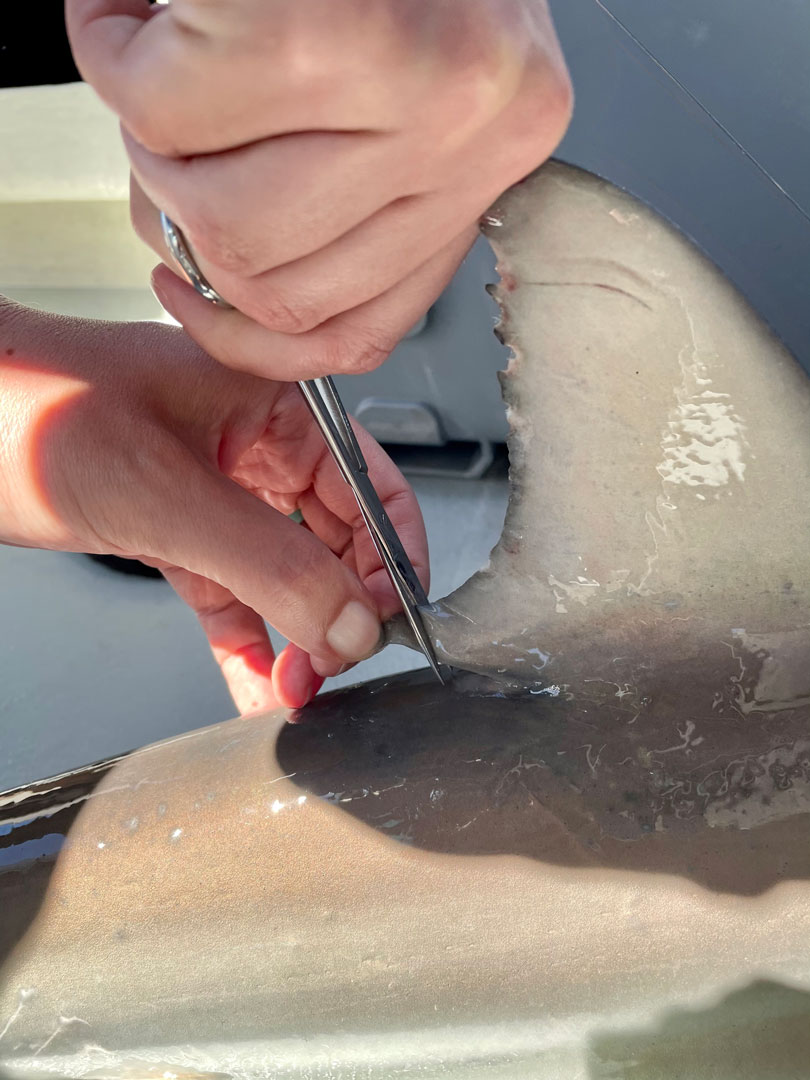What shark immunity can offer to conservation
It is a common misconception that sharks don’t get cancer. Three observations sparked this:
- Studies done in rabbits and calves showed that cartilage inhibits the tumor growth,
- Tumours require new blood vessel formations, or angiogenesis, to grow, and cartilage lacked the ability to form new blood vessels,
- Shark skeletons are strictly made of cartilage. Though this myth has now been disproven, and sharks can get cancer, further studies showed that their adaptive immune system is quite informative in the biomedical context for understanding human immunity.
But what if the shark’s immune system could tell us about their environment? Conservation genetics is the use of DNA collected from animals that can answer questions about movement, life history, population viability, and other metrics that are important for management.

Ph.D candidate Eloise Cave is collecting a small tissue sample from a blacknose shark, Carcharhinus acronotus, for future use in conservation genetic studies. Photo © Caroline Sullivan
Typical methods use DNA extracted from a small tissue sample to sequence regions of the DNA, either microsatellites (short repeats of DNA, i.e. ATCATCATCATC) that have the ability to identify individuals; or mitochondrial DNA that can answer questions like where males and females are migrating and how new species formed. Though useful in answering some conservation-related questions, these areas of the genome are considered neutral, meaning that they do not code for a function in the body like hair colour or eye colour. Functional genes (a.k.a. coding genes) that code for a protein can be highly informative and tell a different side of the story than neutral genes can. This is where shark immunity may play a role. The Major Histocompatibility complex (MHC), a complex of related genes found in all vertebrates, is part of the genome responsible for alloparity, the body’s ability to distinguish its own cells apart from that of an invading pathogen. When an animal is infected with a pathogen from the environment, the MHC will recognize it and respond by triggering an immune response. It can “remember” past encounters with specific diseases and produce a faster and more effective immune response when exposed to that disease again, which is how vaccines operate. Though it evolved in sharks, the adaptive immune system provided such a powerful evolutionary advantage that it has been passed down to all vertebrates, including humans.

A small piece of tissue is collected from the trailing edge of the dorsal fin from sharks. This minimally invasive sampling technique is used to extract DNA and can last for several years, providing data for many projects including studying the MHC genes. Photo © Eloise Cave
At the genetic level, the genes that encode the MHC are known to be highly diverse, driven by the near-limitless variety of microbes in the environment. High genetic diversity in the MHC genes allows the body to recognize more pathogens, creating a more effective adaptive immune system and increasing survivability. Tracking this response in sharks can tell us how sharks are adapting to their environment and where populations may be under pressure. In the future, defining trends in MHC diversity and including these metrics in conservation analyses can help us better define population dynamics, model response to climate change, determine the fitness and viability of species, populations, and habitats, and even locate areas that promote high genetic diversity and can act as refugia for an entire species. Currently, our lab at the Florida Institute of Technology has sequenced regions of the MHC in five different shark species. Early data points to two copies of the MHC genes and high genetic diversity, a necessary feature for their use in conservation genetics studies. Developing this useful tool which is the adaptive immune system in sharks, could open new doors to better understanding shark populations and boosting conservation.
